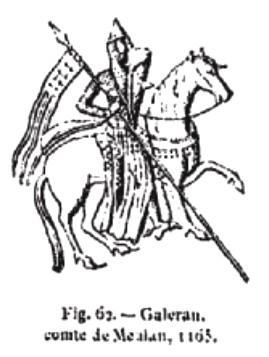
Earl is a rank of the nobility in the United Kingdom. The title originates in the Old English word eorl, meaning "a man of noble birth or rank". The word is cognate with the Scandinavian form jarl, and meant "chieftain", particularly a chieftain set to rule a territory in a king's stead. After the Norman Conquest, it became the equivalent of the continental count. Alternative names for the rank equivalent to "earl" or "count" in the nobility structure are used in other countries, such as the hakushaku (伯爵) of the post-restoration Japanese Imperial era.

Hubert de Burgh, Earl of Kent was an English nobleman who served as Chief Justiciar of England and Ireland during the reigns of King John and of his son and successor King Henry III and, as a consequence, was one of the most influential and powerful men in English politics in the thirteenth century.

Earl of Essex is a title in the Peerage of England which was first created in the 12th century by King Stephen of England. The title has been recreated eight times from its original inception, beginning with a new first Earl upon each new creation. Possibly the most well-known Earls of Essex were Thomas Cromwell, chief minister to King Henry VIII, and Robert Devereux, 2nd Earl of Essex (1565–1601), a favourite of Queen Elizabeth I who led the Earl of Essex Rebellion in 1601.

Henry de Bohun, 1st Earl of Hereford of Pleshey Castle in Essex, was an Anglo-Norman nobleman who became Hereditary Constable of England from 1199.
William de Mandeville, 3rd Earl of Essex was a loyal councillor of Henry II and Richard I of England.
Geoffrey Fitz Peter, Earl of Essex was a prominent member of the government of England during the reigns of Richard I and John. The patronymic is sometimes rendered Fitz Piers, for he was the son of Piers de Lutegareshale, a forester of Ludgershall and Maud de Manderville.
The title of Earl of Gloucester was created several times in the Peerage of England. A fictional earl is also a character in William Shakespeare's play King Lear.
Richard de Luci was first noted as High Sheriff of Essex, after which he was made Chief Justiciar of England.
Hugh de Puiset was a medieval Bishop of Durham and Chief Justiciar of England under King Richard I. He was the nephew of King Stephen of England and Henry of Blois, who both assisted Hugh's ecclesiastical career. He held the office of treasurer of York for a number of years, which led him into conflict with Henry Murdac, Archbishop of York. In 1153, Hugh was elected bishop of Durham despite the opposition of Murdac.

Ranulf de Blondeville, 6th Earl of Chester and 1st Earl of Lincoln, known in some references as the 4th Earl of Chester, was one of the "old school" of Anglo-Norman barons whose loyalty to the Angevin dynasty was consistent but contingent on the receipt of lucrative favours. He has been described as "almost the last relic of the great feudal aristocracy of the Conquest".

Waleran de Beaumont (1104–1166) was an Anglo-Norman nobleman. In his early adulthood, he was a member of the conspiracy of Amaury III of Montfort; later in his career, he participated in the Anarchy and the Second Crusade. During the reign of Henry II of England, Waleran's close ties to Louis VII of France caused him to fall out of grace.
Isabella, Countess of Gloucester, was an English noblewoman who was married to King John prior to his accession.
Events from the 1210s in England.
The Baronial Order of Magna Charta ("BOMC") is a scholarly, charitable, and lineage society founded in 1898. The BOMC was originally named the Baronial Order of Runnemede, but the name was subsequently changed to better reflect the organization's purposes relating to the Magna Charta and the promulgation of "freedom of man under the rule of law."

Geoffrey de Mandeville, 2nd Earl of Essex and 4th Earl of Gloucester was an English peer. He was an opponent of King John and one of the Magna Carta sureties.
Twescard is a former county of the Earldom of Ulster in medieval Ireland. Taking its name from the native Irish territory of in Tuaiscirt, it spanned the northern coastland of County Antrim and County Londonderry. At its height it stretched from Glenarm in the east of the Glens of Antrim to Inishowen in modern County Donegal. It was conquered and settled by Hugh de Lacy and was centered on Coleraine and the lower Bush valley. By the 1460s, the de Mandevilles abandoned and sold their remaining lands in Twescard to the McQuillans who renamed the territory the Route.

Walden Abbey was a Benedictine monastery in Saffron Walden, Essex, England, founded by Geoffrey de Mandeville, 1st Earl of Essex, between 1136 and 1143. Originally a priory, it was elevated to the status of an abbey in 1190.
Hasculf de Tany was an Anglo-Norman nobleman who lived in medieval England, in the region of London. He is believed to have been castellan of the Tower of London.








